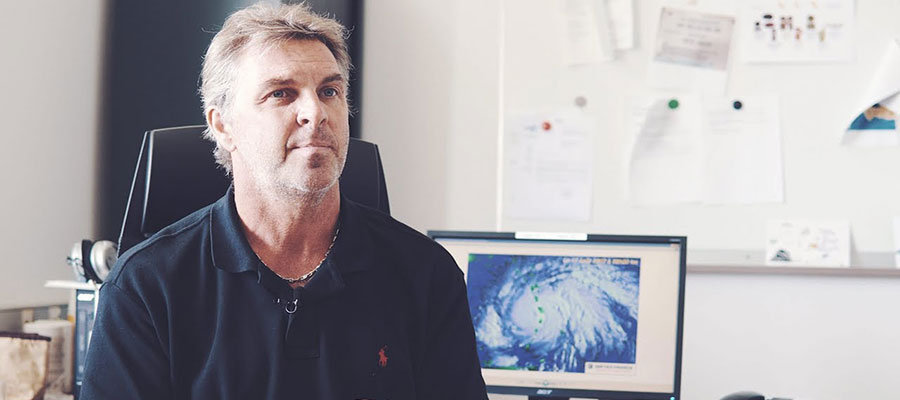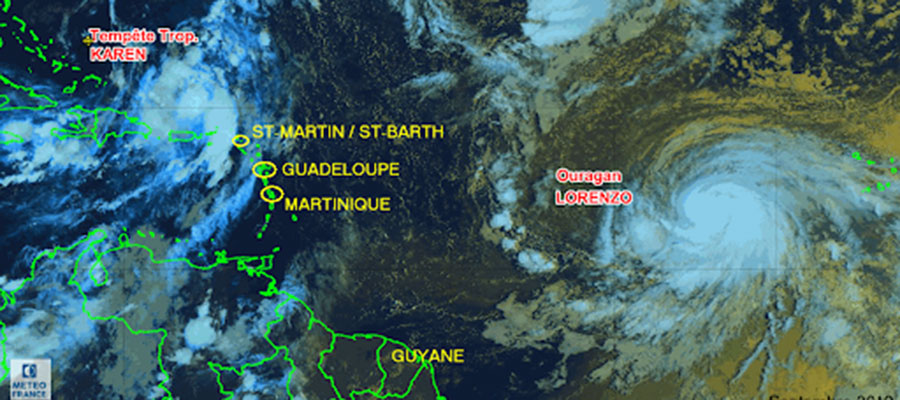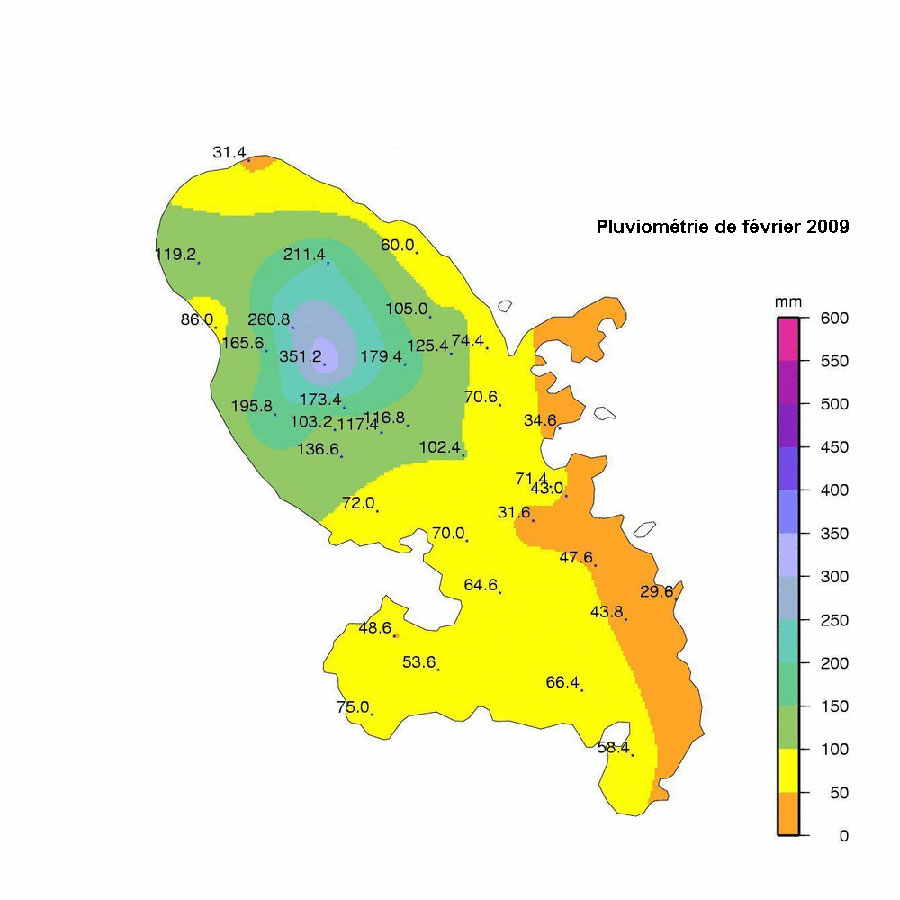He is Martinique’s oracle, the one who can predict whether it will be sunny and hot, cold and damp… and how long it will last! Jean-Nol Degrace, the director of the Météo-France Martinique center, is also a hydrometeorology consultant for the World Meteorological Organization (a UN institution) and the World Bank for cooperation projects, particularly in the Caribbean… in short, the climate of the West Indies holds no secrets for this rum-loving official, who has been in charge for nearly 20 years.

In a previous article (the 2019 cane harvest campaign), a large number of rum producers in Martinique and Guadeloupe had told us of their concerns about the evolution of the climate on their islands. With extreme weather events becoming more common, such as tropical storms that risk damaging sugarcane plants or cause landslides or flooding in fields… or long periods of drought, where a lack of water allows for a higher concentration of sugar within the canes but also drastically reduces yields. So we asked a weather and climate expert to tell us what it was truly like.
Fabien Humbert: First question, are you a rum lover?
Jean-Noël Degrace: Yes, in the sense of an epicurean rather than a connoisseur. That is to say, I like to drink very aged rums from time to time, but I am not a fan of the regular take-off or ti punch. However I don’t consider myself a connoisseur.
And what do you like to taste?
I must admit that I am very Martiniquan about rum because it is here that I can get my hands on the aged rums that I like. For example I still have a bottle of Bally 1929 or a Dillon 1979. I also know a little bit about Guadeloupean, Cuban and Haitian rums, but I appreciate them less. I don’t really have any favorite brands in Martinique, but for example I really appreciate HSE in XO, or Flibuste de la Favorite because I happen to live nearby.
Do you work with rum producers?
Not directly. I regret it because we discussed it several times, notably with Nathalie Guillier-Tual of the BBS group (Trois Rivières and Maison La Mauny), but it did not lead to a collaboration.
How could weather assist the specific agriculture of sugarcane cultivation for agricole rum?
It would bring better anticipation, better planning and a better understanding of what is happening with rainfall, evapotranspiration, sunshine… We can round out this monitoring with projections and trends, not just for the next few days, but also for the next few months, and even for the entire season. For example, the West Indies are suffering from severe water shortages, which are affecting agriculture.
It would be interesting to learn about the reasons of this shortfall and whether or not it will persist in the long run. This is especially significant for sugarcane, whose quantity, quality, and harvesting timing are all heavily influenced by climate factors. For example, in collaboration with Banamart, we created a meteorological service for Martinique bananas. They have a dedicated extranet site, an online human assistance…
These are things that could be implemented for rum and sugarcane. Even if my main function is not to sell Météo-France services, you have to know that overall, assistance to agriculture is often a very profitable service… 1 dollar invested is on average between 6 and 8 dollars earned.
In your 20-year career, what have you noticed as highlights in climate change affecting the French West Indies?
The most convincing parameter is the evolution of temperatures. In Martinique, our robust and homogenized databases show that we are gaining between a quarter and a third of a degree per decade. So on average over sixty years, we have gained about 1.5°C!
This is something that we tend to underestimate, we say to ourselves ‘in the tropics, whether it is 32 or 33.5°C on average, it doesn’t make much difference, whereas it has a huge impact on people’s lives and on agriculture. Vicious circles are set up, since we need to water more while we have less water.
For example, for 3 weeks between August and September this year, we had no trade winds but a strong sun and a humidity level above 60%. If we applied the same grids as in metropolitan France in terms of temperature, we would be between 45 and 50°C. And, in order to combat this, we use more air conditioning, which contributes to the worsening of climate change…
Are drought episodes more and more frequent in Martinique and Guadeloupe?
We must make a difference between meteorological drought related to strong rainfall deficits and hydrological drought. The latter is also very much linked to the human management of water in the territories. In this area, there is much room for improvement, if only to anticipate the fact that with climate change, water resources will be increasingly difficult to manage.
It is possible that in the years to come, the quantity of water will not be very different from today, but it will be distributed differently. That is, we will have drier dry seasons and wetter rainy seasons. In short, we will have more extreme events and we need to take that into account now.
Are tropical storms and cyclones becoming more frequent in the Caribbean?
For the moment, we can’t say that there are more and more of them. First of all, because it is difficult to compare the current period with what happened 100 years ago when we did not have such reliable measuring instruments. Today we are able to track down the slightest meteorological anomaly and give it a name even for a short period of time with no expected impact! However, the main simulations of climate change show that, if the number of cyclones does not increase, among this number the proportion of major hurricanes could increase. They will not necessarily be stronger than those we have known (Allen, Irma …), but the risk is that they are more frequent. What makes things complicated is that it is possible that some regions will be less affected than before, and others will be more affected. Another prediction that could be of interest to rum producers is that these hurricanes will be wetter than before, which can cause flash floods, landslides, mudslides…
How do we fight these hurricanes?
These are natural phenomena that we cannot avoid. But we can prepare for them. Already by explaining to the West Indians what a hurricane really is, what are the consequences, the possible impacts, and how to act with relevance.
The people of Martinique all have the impression that they have already experienced hurricanes but the reality is that most of them have passed more or less far from the island. For 100 years, no major hurricane eye has landed on Martinique.
What people know are the peripheral effects of major hurricanes or weaker hurricanes like Dean in 2007, which passed through the channel of Saint Lucia, or even tropical storms or depressions.
The worst that can happen with a hurricane, Martinique has “never” known. Guadeloupe did, with Hugo, but it is now dated (1989) and the younger generations have not experienced it.
How can rum producers prepare for the arrival of a hurricane?
Agricultural structures can plan ahead of time to better predict and respond to these events. They can better coordinate their operations and timing by examining whether the gutters that allow water to circulate are operational, for example, to prevent the cane from remaining in the water for several weeks….
However, the problem seems to me to be less complicated for cane than for bananas. When a cyclone is approaching, a banana producer has to decide if he will ‘cyclone’ his banana trees himself to avoid them being uprooted. He will lose three months of harvest, but just once. If he doesn’t and his plants are uprooted, he loses nine months and several harvests.
What about the situation in Guyana?
The climate there is very different from the West Indies because it is continental and equatorial. Guyana is not affected by cyclones. The rainfall pattern is very much linked to phenomena such as El Niño and La Niña, which can influence the activity of the Intertropical Convergence Zone (ICZ)… independently of climate change.
The latter will rather exacerbate extreme events, thus longer or more intense rainy seasons and drier dry seasons. These are factors that can impact sugarcane cultivation.
And in the rest of the Caribbean, are there any rum-producing islands that are particularly affected by weather hazards and climate change?
Overall, the further north in the Caribbean you are, the more likely they are to be hit by major hurricanes. Islands like Barbados are therefore relatively protected, even if they are affected by tropical storms. Then, we must take into account the vulnerability of the territory. For example, this year, ‘Laura’ crossed Haiti from east to west and all the conditions were there for large flash floods, landslides and mudslides.
Afterwards, rum-producing islands such as the Dominican Republic or Cuba are also often crossed or bordered by hurricanes, even major hurricanes. Regarding the effects of climate change, all the islands of the Caribbean are impacted by the increase in temperature as well as by the rainfall pattern that may be modified.
The effects of a dry season, very dry and prolonged, or on the contrary, significant cumulative rainfall leading to sustained flooding can have dramatic consequences on agriculture and crops.


